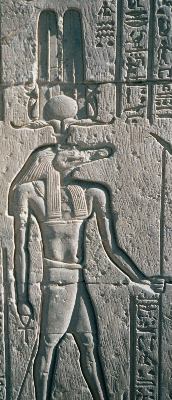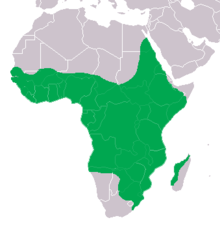Nile crocodile
| Nile crocodile | ||||||||||||
|---|---|---|---|---|---|---|---|---|---|---|---|---|

Nile crocodile ( Crocodylus niloticus ) in Murchison Falls National Park |
||||||||||||
| Systematics | ||||||||||||
|
||||||||||||
| Scientific name | ||||||||||||
| Crocodylus niloticus | ||||||||||||
| ( Laurenti , 1768) |
The Nile crocodile ( Crocodylus niloticus ) is a type of crocodile (Crocodylia) from the family of real crocodiles (Crocodylidae). The species, which usually grow to be 3–4 m long, lives in bodies of water all over Africa and feeds mostly on fish. Occasionally, however, Nile crocodiles can also drag large mammals (e.g. zebras ) underwater and drown them. The Nile crocodile does intensive brood care , the mother guards her nest and protects the young in the first months of life. The species played an important role in Egyptian mythology and was once endangered due to heavy hunting. After hunting was banned in the 1980s, the populations largely recovered.
features
The Nile crocodile is the largest crocodile in Africa and usually reaches lengths of 3 to 4 m. Large females can grow to over 2.8 m long, while large males can grow to over 3.2 m. Very rarely are more than 6 m in length, the maximum is 6.5 m. The snout is 2 times as long as it is wide at the base. The oar tail is strong and flattened on the sides. Adult Nile crocodiles are dark olive-colored on top, the belly is uniformly porcelain-colored. The young are light olive-colored and darkly spotted and banded. The color of the crocodiles is strongly influenced by the substances dissolved in the water.
Distribution, habitat and subspecies
The Nile crocodile inhabits almost all of Africa including Madagascar , but is absent in the extreme south-west of Africa, in the Sahara (except for an isolated occurrence in the Guelta d'Archei ) and in eastern Madagascar. It used to inhabit the entire length of the Nile , but is now only found in the upper reaches of Aswan . The species inhabits numerous habitats, such as rivers, ponds, lakes, swamps and mangroves.
There are currently seven geographic subspecies. Genetic studies lead to speculation that some of them may also be regarded as separate species:
- Crocodylus niloticus africanus : Southern Tanzania , Zambia , Malawi , Mozambique , Eastern Namibia .
- C. n. Chamses : Equatorial Guinea , Gabon , Republic of the Congo , Zaire , southern Sudan , Uganda , Rwanda , western Tanzania, northern Zambia, Angola , northern Namibia.
- C. n. Cowiei : Zimbabwe , Botswana , South Africa .
- C. n. Madagascariensis : Madagascar.
- C. n. Niloticus : southern Egypt , Sudan, western Ethiopia .
- C. n. Pauciscutatus : Eastern to Southern Ethiopia, Somalia , Kenya .
- C. n. Suchus : Southern Mauritania , Senegal , Gambia, Guinea , Ghana , Togo , Benin , Nigeria , Cameroon , Burkina Faso , Mali , Niger , Chad , Central African Republic . (Is now regarded as a separate species, see: West African crocodile ( Crocodylus suchus ))
The subspecies are differentiated based on their Pholidose .
Nile crocodiles have also been spotted in the Florida Everglades in recent years. It is believed that these were illegally introduced by humans and that they reproduced there as neozoons .
In historical times the Nile crocodile was also found in Algeria , Israel and the Comoros .
Way of life
activity
During the day, Nile crocodiles usually sunbathe on the bank, at night the crocodiles go into the water. On the large African rivers, which do not dry up seasonally, Nile crocodiles are active all year round. Crocodiles living in smaller bodies of water that dry out seasonally remain significantly smaller (2.4–2.7 m) than crocodiles in permanent bodies of water. They spend the dry season in 9–12 m long burrows that end in a chamber with some air holes. Up to 15 crocodiles survive the drought in such a chamber.
nutrition
Nile crocodiles go into the water at night to hunt - they are generalist carnivores. The main component of the diet of adult Nile crocodiles is fish; in Lake Rudolf in northern Kenya, fish make up 90 % of the diet , in the Okavango Delta of Botswana, subadult specimens make up 68% of the diet. Other prey animals are birds, turtles and small mammals. Large Nile crocodiles can also hunt large mammals. They usually lie in wait for prey under the surfaces of rivers or water places where the animals come to drink, and go unnoticed by the flat profile of the head and the almost noiseless movement. The victim is then jumped on, grabbed in a jump, dragged into the water and drowned. Among other things, there were reports of zebras, antelopes, porcupines, young hippos and also predators such as hyenas and lions that had been captured by Nile crocodiles. Carrion is also part of the diet of the Nile crocodile.
Young Nile crocodiles feed on much smaller prey. Annual Nile crocodiles in the Okavango Delta feed 45.6% on insects and spiders, 30.8% on small mammals and only 11.6% on fish. The food spectrum of young crocodiles also includes amphibians and reptiles, which, however, are relatively rarely hunted.
Social behavior and reproduction
Nile crocodile females are not territorial . The males form territories and stubbornly defend a section of the bank against other males. They regularly swim the borders of their territory and drive away intruders. Fighting occurs occasionally.
The mating season is very variable within the large distribution area. When a male meets a female, it raises its tail and head and roars. It swims towards the female, which finally also lifts its head and roars. The male places his front legs on the female to mate and rises from the side onto her back. After 5 months the female lays 16–80 eggs weighing 85–125 g. The time of oviposition, as well as the mating season, is highly variable. In Tanzania, for example, eggs are laid in November, on the Victoria Nile and Lake Albert from late December to early January, on Ruzizi between April and August and in Madagascar from September to October. The female digs a 35-40 cm deep hole in the ground with her hind legs about 5–10 m from the water, in which the eggs are laid. The hole is then covered and a nesting mound made of substrate and plant residues is piled up. During incubation, the female guards her nest from predators such as the Nile monitor ( Varanus niloticus ), to which the crocodiles often lose eggs. After 84-89 days, the young in the eggs announce their hatching with frog-like sounds. The female then digs up the nest again and carries the hatchlings into the water in her mouth. In the first months of life, the young always stay close to their mother, who is guarding them. The mother draws attention to approaching enemies by strong body vibrations, whereupon the young animals dive immediately. Young animals that have been separated from the group or are attacked utter a cry for help, whereupon the female immediately rushes to the young animal to defend it. The young animals spend the night on their mother's back. Nevertheless, in the first few weeks more than 50% of the young are often victims of crabs, large fish, Nile monitor lizards, herons , storks , hyenas and mongooses .
Nile crocodiles and people

Danger
In the first half of the 20th century, Nile crocodiles were very common across Africa. In the decades that followed, the population sank drastically as they were heavily hunted for their skin. Crocodile leather is processed into numerous products such as handbags, belts, etc. Additional incentives to hunt were given by shooting prizes for the crocodiles, as they were seen as a threat to the population. In the 1980s, hunting declined due to bans and crocodile farms can now meet the needs of the leather industry. The Nile crocodile is one of the most commonly kept species on these farms.
The IUCN Red List of IUCN led the Nile as endangered until 1996 ( vulnerable ), now the species is considered not threatened ( least concern ). In the Nile, however, the animals are rarely found in the wild, they live in nature reserves in wide, sluggish bays.
Cultural references
See crocodiles in ancient Egypt .
During excavations of historical tombs , mummified Nile crocodiles were also found. In 2012, some well-preserved specimens were given to a museum at the temple complex of Kom Ombo .
Several songs are dedicated to the Nile crocodile , for example Das Krokodil am Nil or Krokodil Theophil and others.
Attacks on people
Large Nile crocodiles can attack people who carelessly enter crocodile waters; However, attacks have become much rarer than in the past due to the enormous collapse in stocks in the 20th century. Most incidents are the result of high spirits or inattentiveness on the part of the victims. CrocBITE, the global database for crocodile attacks from Charles Darwin University , registered 557 attacks by Nile crocodiles on humans so far (as of January 2014), 394 of which were fatal for the victim. Only the saltwater crocodile are known to have more attacks on humans.
At the beginning of the 21st century there are more and more conflicts between crocodiles and local people, because on the one hand the population is increasing rapidly, on the other hand the crocodile populations are also recovering. The local population also complains that more and more cattle are being torn down and fishing nets are increasingly being damaged by crocodiles.
literature
- L. Trutnau & R. Sommerlad (2006): Crocodiles. Biology and attitude . Edition Chimaira, Frankfurt am Main. ISBN 3-930612-96-8
Web links
Individual evidence
- ↑ a b c M. Rogner (1994): Echsen 2 , p. 240. Eugen Ulmer Verlag. ISBN 3-8001-7253-4
- ↑ Jonathan Hutton: Movements, Home Range, Dispersal and the Separation of Size Classes in Nile Crocodiles . In: American Zoology . tape 29 , no. 3 , 1989, pp. 1033-1049 , doi : 10.1093 / icb / 03/29/1033 .
- ↑ a b Trutnau & Sommerlad (2006)
- ↑ Crocodylus suchus in The Reptile Database
- ↑ Exotic import: Researchers discover Nile crocodiles in Florida. In: Spiegel Online . May 21, 2016. Retrieved June 9, 2018 .
- ↑ Crocodile Specialist Group, Richard A. Fergusson: Nile Crocodile Crocodylus niloticus (online: PDF )
- ^ A b K. M. Wallace & AJ Leslie (2008): Diet of the Nile Crocodile (Crocodylus niloticus) in the Okavango Delta, Botswana . Journal of Herpetology 42 (2), pp. 361-368
- ↑ Bernhard Grzimek (1979 ed.): Grzimeks Tierleben Kriechtiere , p. 136. Bechtermünz Verlag, Augsburg 2000 (unchanged reprint of the dtv edition from 1979). ISBN 3-8289-1603-1
- ↑ Crocodylus niloticus in the endangered Red List species the IUCN 2010. Posted by: Crocodile Specialist Group, 1996. Accessed January 16, 2011th
- ↑ Kom Ombo Crocodile Museum , accessed May 28, 2020.
- ↑ The crocodile on the Nile. The 30 best play and movement songs on www.youtube.com, accessed on May 28, 2020.
- ↑ Krokodil Theophil, sung by Vaclar Neckar; 1:36 minute ,
- ^ G. Webb & C. Manolis (1989): Australian Crocodiles - A Natural History , p. 41. Reed New Holland, Sydney, Auckland, London & Cape Town 2007 (reprint of the original edition from 1989). ISBN 9781876334260
- ^ CrocBITE - Worldwide Crocodilian Attack Database , accessed January 26, 2014




